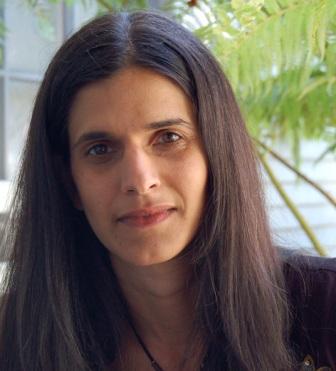

|

|
IN MEMORIAM
Beatriz da Costa
Associate Professor of Art
UC Irvine
1974 - 2012
Da Costa, an interdisciplinary artist known for her work at the intersection of contemporary art, science, engineering, and politics, died in New York in December 2012 from the complications of metastasized breast cancer.
Da Costa came to UC Irvine in 2003 to join the Art Computation Engineering (ACE) graduate program in its inaugural year. ACE alumni remember her as an inspiring, vigorous, and challenging teacher and adviser. Initially Beatriz’s appointment was a joint one between the Departments of Studio Art (now the Department of Art) and Electrical Engineering and Computer Science. After the ACE program closed in 2009, Da Costa became a fulltime member of the Art department. She also became affiliate faculty in the Informatics department, as well as the Culture and Theory Ph.D. program, due both to her own background and practice and to the desire of students from a wide variety of academic disciplines to work with her. In 2007, after receiving tenure as an associate professor, she began work on a Ph.D. in the History of Consciousness program at UC Santa Cruz.
Beatriz’s life was cut tragically short, but she packed a great deal of intellectual adventure into her 38 years. Known affectionately as "Shani" to friends and family, Beatriz was born in Berlin, Germany, and grew up in Ahrensburg, a small town on the outskirts of Hamburg. Beatriz faced the prospect of death from a very young age, after being diagnosed and aggressively treated for a non-Hodgkins lymphoma at ages 14, 19, and 21. Her treatments were successful, and she remained cancer-free for many years thereafter. Due to the illnesses she experienced in her youth, however, Beatriz lived with the sense that time was precious. Throughout her life, she traveled extensively, visiting her father's family in Goa, India, and becoming familiar with much of Europe and parts of Africa and the Middle East during her professional life.
In 1995, Beatriz moved to southern France to study art at the Ecole d’Art d’Aix-en-Provence, a place for which she always retained a special fondness. It was here that her interest in the intersection of art and technology really took off. As part of an exchange program, she moved to Pittsburgh in 1999 to pursue
studies at Carnegie Mellon University. She briefly taught at Chatham College, then as a visiting assistant professor at the State University of New York in Buffalo, before coming to UC Irvine.
Beatriz was a fierce and fearless proponent for social justice, and she challenged inequity whenever and wherever she could. Her artwork took whatever form served it best, and over the course of her career she worked with robotics, micro-electronics, installation, sculpture, performance, interactivity, net art, photography, and video — and often with some combination thereof. She also considered writing an important part of her practice, co-editing the 2008 MIT Press anthology Tactical Biopolitics: Art, Activism, and Technoscience with UC Irvine faculty member Kavita Philip (Department of History). She was especially interested in creating work that bridged the arts and sciences, and she frequently engaged the public by running workshops that translated challenging new technical and scientific developments into something accessible to a more general public. Some of her better-known projects include works done in collaboration with Critical Art Ensemble, with which she collaborated between 2000 and 2005 on such projects as Molecular Invasion, Free Range Grains, and GenTerra. She also did a number of projects with a group she co-founded, Preemptive Media, including Zapped, and Air, and Swipe—the last of which was shown at UC Irvine’s Beall Center for Art & Technology in 2004. Her project Pigeonblog— an experiment in using homing pigeons to monitor air quality — remains perhaps her best-known work.
Beatriz exhibited these projects internationally at venues such as the Andy Warhol Museum, the Centro Andaluz de Arte Contemporáneo in Sevilla (Spain), the Zentrum für Kunst und Medien (Germany), the Museum of Contemporary Art, (Serbia), Exit Art Gallery (New York), Cornerhouse (UK), Saidye Bronfman Centre for the Arts (Montreal), and the Natural History Museum in London. She received grants and residencies to support her work from Creative Capital, the Durfee Foundation, Eyebeam Art + Technology Center, and the Inter-Society for Electronic Arts. She also received an Honorary Mention from the Adobe Emergent Artists Award and an Honorary Mention at the Prix Ars Electronica and was twice nominated for the Rockefeller New Media Arts grant.
In 2010, Beatriz went to New York for treatment of her cancer, which had by then spread to her brain, and while there she began what became her final work, a series of projects—The Life Garden, Dying for the Other, The Delicious Apothecary, and The Anti-Cancer Survival Kit— that grew out of her experience with cancer and focused on helping others with the disease. At the same time, she continued to show work, give artist’s talks, and undertake limited artist’s residencies, and she even took up the study of video production and typography. She often did all of this while in great pain and—in the last several months of her life—while her ability to walk, her motor skills, her hearing, and her vision deteriorated. Through all of the physical challenges, the anxiety, and the many smaller challenges of daily life with cancer, she never stopped planning for the future. Her fierce, indomitable spirit will be much missed.
Robert Nideffer
Professor, Department of Art